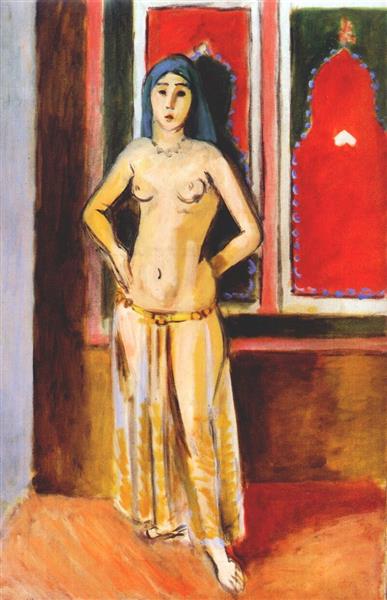Description
The painting "Odalisque" from 1923, one of Henri Matisse's celebrated works, exemplifies the artist's distinctive ability to combine a vibrant use of color with a composition that exudes sensuality and exoticism. When observing this 39 x 60 cm composition, one cannot help but be captivated by the exuberance and elegance of the central figure, an odalisque, who displays an innate grace over the sober platform of her surroundings.
The model is presented reclining, adorned in an intense red dress, whose brightness is accentuated by the rich and detailed textile motifs surrounding her. Matisse, in his long-documented interest in the cultures of North Africa and the Middle East, employs these adorned elements to transport the viewer to a world of luxury and opulence. The blue curtains and the elaborately decorated carpet not only serve as a backdrop but also intensify the sense of depth and texture, a clear testament to the artist's talent in manipulating pictorial space.
The face of the odalisque is one of serenity and reverie, with half-veiled eyes that seem to look beyond the tangible plane of the canvas. The contrast of her pale skin with the vibrant colors of her surroundings highlights her presence, and the relaxed posture of her body adds an air of naturalness and confidence. This focus on the human figure, enhanced by an exotic environment, is a recurring motif in Matisse's work, particularly in his odalisques, which transcend mere physical representation and evoke worlds of interpretation.
The use of color in this work deserves special attention. True to his style, Matisse uses a vibrant and contrasting palette to evoke emotions and define forms. The reds and blues intertwine in a visual symphony that, far from saturating the view, guide the observer through the canvas with an almost musical harmony. Each shade not only delineates figures but also establishes a subtle rhythm and movement that are unmistakable in Matisse's work.
Henri Matisse, one of the main exponents of Fauvism, continued to evolve his style throughout his career, and "Odalisque" from 1923 is a reflection of the peak of his artistic exploration. The influence of Fauvism - a movement that Matisse helped to found where color is used in an intensely expressive manner - is palpable in this piece. However, the work also indicates a transition towards a more ornamental and decorative approach, influenced by his travels and his appreciation for Islamic art.
In Matisse's vast repertoire, the odalisques occupy a fundamental place not only for their visual beauty but also because they encapsulate the artist's approach to form, color, and sensuality. "Odalisque" from 1923 is not just a celebration of the female figure, but also a tribute to Matisse's ability to turn the canvas into a portal to rich and complex universes, where each color, line, and detail are imbued with life and expression.

